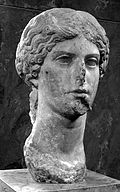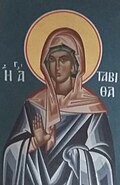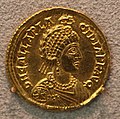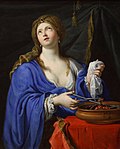List of 999 women of the Heritage Floor / Marcella
This list describes the place settings for Marcella on the table of Judy Chicago's art installation The Dinner Party . It is part of the list of 999 women on the Heritage Floor who are assigned to the respective place settings on the table. The names of the 999 women are on the tiles of the Heritage Floor, which is arranged below the table and belongs to the art installation.
description
The installation consists of a three-sided table, each with 13 historical or mythological personalities, thus a total of 39 people, from prehistory to the women's rights movement . These people were assigned a place setting at the table, consisting of an individually designed table runner, an individually designed plate, a goblet, knife, fork, spoon and serviette. The first page of the table is devoted to prehistory up to the Roman Empire , the second to Christianization up to the Reformation and the third from the American Revolution to the women's movement. Each place setting on the table is assigned additional personalities who have received an entry on the tiles of the Heritage Floor, which occupies the space under the table and the center of the space between the sides of the table. This list includes the personalities assigned to Marcella's place setting. Your seat is on the second side of the table.
Hints
In addition to the names as they are used in German transcription or in scientific usage, the list shows the spelling chosen by Judy Chicago on the tiles.
The information on women who do not yet have an article in the German-language Wikipedia is referenced by the individual references listed under comments . If individual information in the table is not referenced via the main article, additional individual references are given at the relevant point. If there are any discrepancies between the information provided in Wikipedia articles and the descriptions of the work of art on the Brooklyn Museum website , this will also be indicated under Comments.
Place setting for Marcella
Marcella wasbornin Rome around 325. She refused a remarriage after the death of her husband, which is common for noble Roman women and instead chose an ascetic lifeconsecrated to Christ . She had conversations with Hieronymus and discussed with him. In her house she gathered around her a group of other young women and widows with whom she lived and prayed in asceticism. This makes her the first nun of the Christian Church and a pioneer of monastic life. When the Goths invaded Romeunder their leader Alaric I and plundered themin 410, she was badly mistreated. She was able tosaveherself to a church where she died of her injuries. She is considered a martyr of the early church.
The place setting for Marcella is designed with Christian symbols and the symbols of her holiness. The main design feature of the table runner is an architectural plan of early Christian basilicas . Her name is embroidered in the area that represents the transept in front of the altar and indicates her importance for the development of Christianity. The front of the runner is made of woven camel hair . From this material the hair shirts were made, which were worn by early Christians and members of the ascetic women's convent she founded. These shirts, whose rough fibers irritated the skin, were worn under clothing as a penance. The initial letter “M” on the front of the runner is designed with the figure of a praying woman who prays in the pre-Christian pose of a goddess with arms outstretched and hands turned upwards. It is a reminder of how early pre-Christian symbols were chosen and appropriated by the new church for its own iconography .
On the back of the table runner there are other symbols that shaped the early church and Marcella's life. The scroll represents learning in the monasteries, which in early society was often the only place of education for women. Below are the symbols of a fish, a staff and a triangle, which are combined to form a picture. The triangle, an early symbol of female genitalia, first became a symbol of the goddess and sacred femininity, but in Christianity it also represents the Holy Trinity . The stick stands as a symbol for the "Good Shepherd". It also symbolizes the leadership and authority conferred on bishops. The fish served the early Christians in times of Christian persecution as a symbol of their faith. These symbols are supposed to represent Marcella as the “savior of women” in early Christian times. The last symbol is the ship, it represents the Christian Church that sails through the "dangerous waters". His presence is intended to connect Marcella's life, including all dangers, with the development of the Church and Christian monasteries.
| Surname | Spelling on the tile | Date of birth | cultural spatial assignment | Remarks | image |
|---|---|---|---|---|---|
| Agrippina the Elder | Agrippina I | 14 BC Chr. | Roman Imperial Era | Married to Germanicus , she accompanied him into battle during the wars. After his death she was independently politically active in Rome and, together with her two sons, was accused of trying to overthrow Emperor Tiberius . She was then banished. |

|
| Agrippina the younger | Agrippina II | 15 or 16 AD | Roman Imperial Era | Daughter of Agrippina the Elder, born in Oppidum ubiorum , mother of Nero and wife of Emperor Claudius ; she is considered the founder of Cologne . |

|
| Anastasia | Anastasia | before 300 | Roman Imperial Era | Roman empress. | |
| Caelia Macrina | Caelia Macrina | 150 BC Chr. | Roman Republic | Established a food fund for girls that was more generous than usual at the time. | |
| Dorcas | Dorcas | N / A | Bible , New Testament | Disciple of Jesus in the New Testament, also known under the name Tabitha. |

|
| Eustochium | Eustochium | at 368 | Late antiquity | Consecrated virgin , studied with Hieronymus and founded monasteries in Bethlehem with her mother Paula. |

|
| Fabiola of Rome | Fabiola | 4th century | Late antiquity | Roman benefactress and saint . |

|
| Galla Placidia | Galla Placidia | 388 | Late antiquity | Mother of the future emperor Valentinian III. and as such, de facto regent of the Western Roman Empire for several years . |

|
| Helena | Flavia Julia Helena | 248/250 | Roman Imperial Era | Wife of the Roman Emperor Constantius Chlorus and mother of the Emperor Constantine the Great. She is an important figure in the history of Christianity and the world because of her influence on her son and her own contributions to put Christianity at the center of Western civilization. |

|
| Julia Domna | Julia Domna | 2nd century | Roman Imperial Era | Roman empress, wife of Septimius Severus and mother of the emperors Caracalla and Geta . |

|
| Julia Maesa | Julia Maesa | 2nd century | Roman Imperial Era | She helped her two grandchildren one after the other to become emperor and thus ensured the continuation of the Severan dynasty . |

|
| Julia Mamaea | Julia Mamaea | 2nd century | Roman Imperial Era | Mother of the Roman Emperor Severus Alexander , who ruled from 222 to 235. At first she was de facto regent because of the young age of her son . |

|
| Livia Drusilla | Livia Drusilla | 58 BC Chr. | Roman Imperial Era | Third wife of the Roman emperor Augustus , was the first Roman woman to bear the imperial title of Augusta , posthumously elevated to goddess by her grandson, Emperor Claudius . |

|
| Lydia | Lydia | 1st century AD | Roman Imperial Era | Purple merchant , took the apostle Paul of Tarsus and his companion Silas into her house and was baptized and the families of her house ; it is mentioned in the Acts of the Apostles . |

|
| Makrina the younger | Macrina | at 330 | Late antiquity | Consecrated virgin , elder sister of Basil the Great , Gregory of Nyssa , Peter of Sebaste . Outstanding spiritual figure venerated as a saint in the Armenian, Catholic , Orthodox and Anglican churches. |

|
| Marcellina | Marcellina | 330 to 335 | Late antiquity | Early Christian consecrated virgin and martyr. She was the older sister of the church father, Ambrosius . |

|
| Mary Magdalene | Mary Magdalene | N / A | Bible , New Testament | Companion of Jesus and witness of the resurrection . |
|
| Mary of Bethany | Mary of Bethany | N / A | Bible , New Testament | Is mentioned in biblical stories in the 10th chapter of the Gospel of Luke and in the 11th chapter of the Gospel of John . |

|
| Martha of Bethany | Martha of Bethany | N / A | Bible , New Testament | Figure of the New Testament , sister of Mary . |

|
| Octavia Minor | Octavia | around 69 BC Chr. | Roman Republic | Due to her virtue, kindness, loyalty to her husband and non-interference in politics, she was considered to be one of the best-known noble models for the traditional Roman ideas of the role of matrons , who were to be limited to their duties as mother and housewife. |

|
| Paula of Rome | Paula | 347 | Late antiquity | Roman Christian , widow and saint of the Catholic Church . She is best known for her friendship with the church father Hieronymus . |

|
| Phoibe | Phoebe | 1st century | Bible , New Testament | A woman who was in the service of the ancient Christian community of Kenchreä near Corinth. It is mentioned by the apostle Paul in his letter to the Romans ( Rom 16.1 EU ). | |
| Plotina | Plotina | before 70 | Roman Imperial Era | Wife of the Roman Emperor Trajan . |

|
| Porcia | Porcia | before 67 BC Chr. | Roman Republic | Daughter of the Roman politician Marcus Porcius Cato the Younger and wife of the Caesar murderer Marcus Iunius Brutus . |

|
| Priscilla and Aquila | Priscilla | 1st century | Late antiquity | Married couple and well-known missionaries of early Christianity in the area of some churches in Asia Minor and Corinth . |

|
- Individual evidence
- ↑ Brooklyn Museum: Marcella. In: brooklynmuseum.org. Retrieved October 19, 2019 .
- ↑ Brooklyn Museum: Caelia Macrina. In: brooklynmuseum.org. Retrieved October 19, 2019 .
- ↑ Brooklyn Museum: Dorcas. In: brooklynmuseum.org. Retrieved October 19, 2019 .
Web links
- Brooklyn Museum, Marcella
- The Dinner Party on the website of Through the Flower , Judy Chicago's non-profit organization